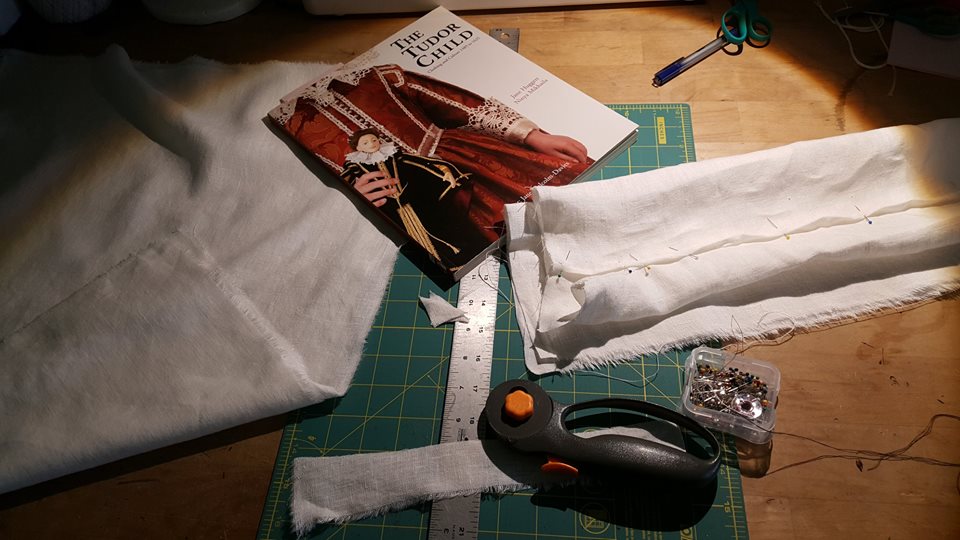Make a seam. Iron (or finger press) the seam open. Working from right to left (if you’re right-handed) on the face of the garment work a back stitch where the stitch showing on the face of the garment goes over 1-2 threads leaving a little tiny stitch showing. On the back the stitch will be much longer. This will hold…
Basting Stitch
A long loose stitch used to hold two pieces of fabric together. This is normally either hidden in seam allowance or intended to be removed once the garment is completed. This is one of the pieces of the skirting to my son’s new doublet. To give the skirting a bit of body I’ve added some linen canvas interlining. First I…
Late period breeches for a 5-year-old
Brown wool lined in natural linen breeches sized for a 5-year-old started March 6, 2019. Finished March 11, 2019. Continuing with the theme of “clothe the child” I made a pair of “Gorinchem breeches to fit a child aged ten years” shown in “The Tudor Child” (p. 94-95)(https://amzn.to/2ld5iZS). My son is only 5.. but he’s a HUGE 5-year old. Technically…
Being
When you say to someone “draw a tree,” what they draw is, no matter how complex, visual shorthand for a tree. The picture does not capture the “being” of a tree. The beauty of the limbs. The complexity of a leaf. The texture of the bark. The sweet clean “tree” smell. In much the same way, when we say “I’ve…
Late period shirt for a 5-year-old
White linen shirt sized for a 5-year-old started June 15, 2018. Finished March 4, 2019. To be fair making this shirt went fairly quickly. Unfortunately I started making this for my son and then got pulled off to a lot of other projects. It probably only took about a week to sew it together but that was spread out over…
Tunic Sew Along: Finish your tunic
[Late to the conversation? See all of the tunic sew-along from the beginning] Step 6: Finish your tunic. Someone in my FaceBook page (Research Dumping Ground), asked “Why do you sew flat felled seams with the flap on the outside?” Good question. Initially, when I first started sewing tunics (2003-2004), it was because no one told me any different. Jeans…
Slip Stitch
I use the slip stitch for rolled hems, attaching linings and for applique. This is a stitch my mother taught to me and I use it on practically every garment I’ve ever made. I am right handed so if you’re left-handed you’ll have to do the mental gymnastics to reverse this. For my example I’m using brown button hole thread…
Tunic Sew Along: Trim your hem
[Late to the conversation? See all of the tunic sew-along from the beginning] Step 5: Trim your hem. If I were working on a full length tunic or a dress I’d have the recipient try it on with the shoes they plan to wear and a belt/appron if they plan to wear that and then mark where it hits the…
Tunic Sew Along: Construct your tunic
[Late to the conversation? See all of the tunic sew-along from the beginning] Step 4: Construct your tunic. First things first, thread. Use whatever thread makes you happy. For the construction of a tunic I like a nice 100% cotton thread or something with a polycore. I’ve been told that 100% silk or poly threads will cut through your fabric…
Anatomy of woven fabric
A loom holds the warp threads. The weft threads are then woven into the warp threads in a particular pattern. These are compacted to create fabric. The area at each edge of the warp where normally the weft threads change direction is referred to as the selvedge. When viewing a piece of fabric the warp threads will run parallel to…









